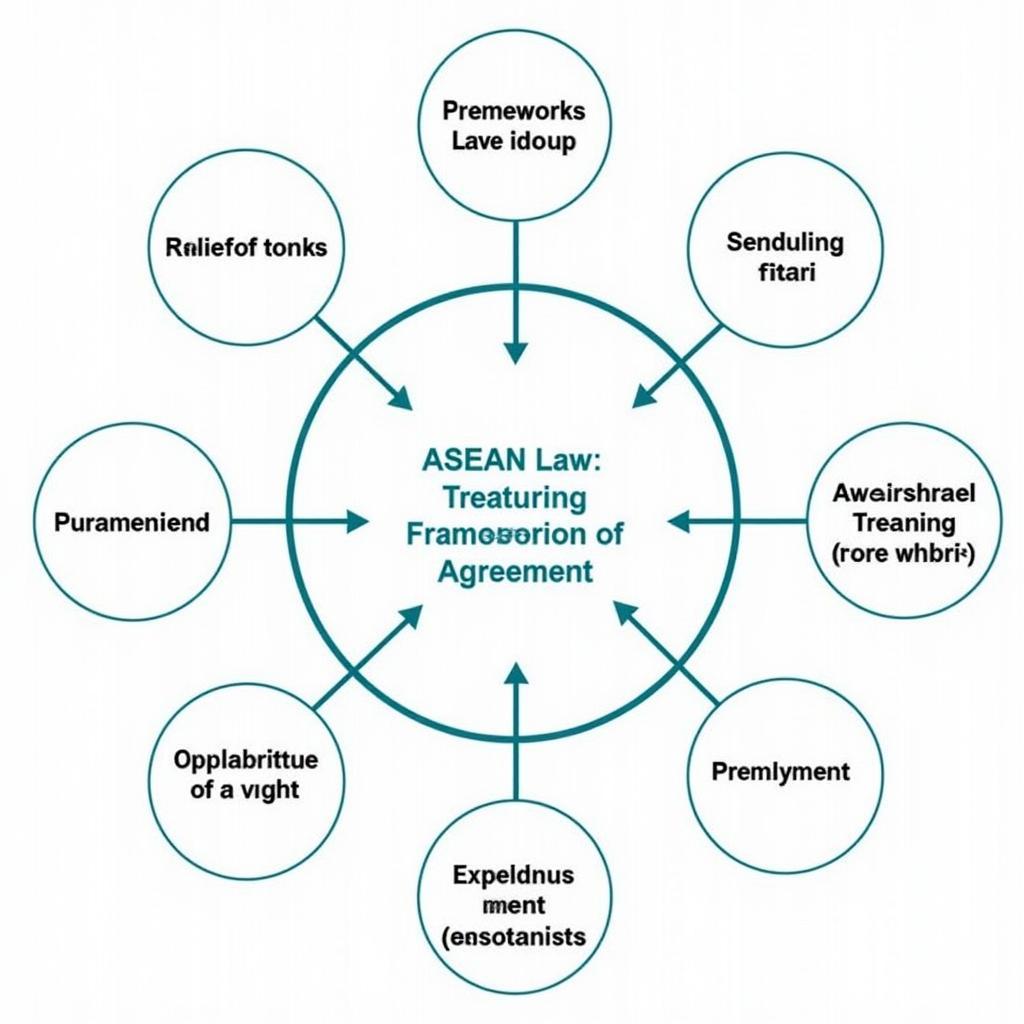The Association of Southeast Asian Nations (ASEAN) stands as a testament to regional cooperation and integration. Established in 1967, this intergovernmental organization plays a crucial role in promoting economic, political, and socio-cultural development within Southeast Asia. ASEAN Law, a complex and multifaceted system, forms the backbone of this regional integration. This comprehensive guide delves into the depths of ASEAN Law, exploring its significance, key features, and impact on the region.
 ASEAN Law Framework
ASEAN Law Framework
What is ASEAN Law?
ASEAN Law encompasses a vast body of legal instruments, agreements, and treaties that govern the relationships between ASEAN member states and provide a framework for their collaboration. Unlike traditional legal systems with binding laws, ASEAN Law operates based on the principle of “ASEAN Consensus,” emphasizing consultation, cooperation, and non-interference in internal affairs. This unique characteristic stems from the diverse political systems and legal traditions of ASEAN member states.
The Importance of ASEAN Law
ASEAN Law serves as the cornerstone of regional integration and cooperation in Southeast Asia. By fostering a rules-based framework, ASEAN Law provides:
- Economic Integration: Facilitates trade liberalization, investment flows, and economic cooperation among member states.
- Political Stability: Promotes dialogue, conflict prevention, and peaceful resolution of disputes.
- Social and Cultural Development: Encourages cultural exchange, people-to-people connectivity, and addresses transnational challenges like climate change and disaster management.
Key Features of ASEAN Law
ASEAN Law stands out due to its distinct characteristics, which include:
- ASEAN Consensus: Decisions and agreements are reached through consultations and mutual consent, respecting national sovereignty.
- Non-Interference: Member states refrain from interfering in the internal affairs of other member states.
- Gradualism: ASEAN Law evolves incrementally, allowing member states to adapt to agreements and treaties at their own pace.
- Soft Law Approach: Emphasizes voluntary compliance and capacity building rather than strict enforcement mechanisms.
The Evolution of ASEAN Law
From its inception, ASEAN Law has undergone significant development, reflecting the organization’s growing ambition and the region’s evolving needs. Key milestones include:
- 1967 Bangkok Declaration: Established ASEAN’s foundational principles of cooperation and regionalism.
- 1992 ASEAN Free Trade Area (AFTA): Launched the journey towards economic integration, gradually eliminating tariffs and trade barriers.
- 2008 ASEAN Charter: Transformed ASEAN into a rules-based organization with legal personality, enhancing its effectiveness and global standing.
- 2015 ASEAN Community Vision 2025: Outlines a roadmap for building a highly integrated and cohesive ASEAN Community across political-security, economic, and socio-cultural pillars.
Challenges and Opportunities for ASEAN Law
While ASEAN Law has made significant strides, it faces challenges:
- Enforcement Mechanisms: The lack of strong enforcement mechanisms can hinder the implementation and effectiveness of agreements.
- Harmonization of Laws: Differences in legal systems and domestic laws among member states pose challenges for harmonization.
- Emerging Issues: Addressing contemporary issues like cybersecurity, digital trade, and pandemics requires continuous adaptation and evolution of ASEAN Law.
Despite these challenges, ASEAN Law presents numerous opportunities:
- Strengthening Economic Integration: Deepening economic cooperation through initiatives like the Regional Comprehensive Economic Partnership (RCEP) can boost regional trade and investment.
- Enhancing ASEAN’s Global Role: A robust legal framework can elevate ASEAN’s standing in global affairs and allow it to play a more active role in shaping international norms and standards.
ASEAN Law and Regional Integration: Success Stories
ASEAN Law has facilitated notable achievements in regional integration:
- ASEAN Free Trade Area (AFTA): AFTA has significantly boosted intra-ASEAN trade, turning the region into a global economic powerhouse.
- ASEAN Single Aviation Market (ASAM): ASAM promotes air connectivity within Southeast Asia, facilitating tourism and economic growth.
- ASEAN Agreement on Transboundary Haze Pollution: This agreement showcases ASEAN’s commitment to addressing transboundary environmental challenges through collaborative action. You can learn more about the ASEAN Agreement on Transboundary Haze Pollution source of law on our website.
 ASEAN Leaders at a Summit
ASEAN Leaders at a Summit
Conclusion: ASEAN Law as a Catalyst for a More Integrated and Prosperous Region
ASEAN Law, while evolving, plays a crucial role in promoting regional integration, economic prosperity, and social progress within Southeast Asia. As ASEAN continues to navigate a complex and interconnected world, strengthening its legal framework will be essential to address emerging challenges and seize new opportunities. By embracing the spirit of ASEAN Consensus and working collaboratively, member states can further enhance ASEAN Law’s effectiveness in realizing a peaceful, stable, and prosperous Southeast Asia.
Frequently Asked Questions (FAQs)
1. What is the role of the ASEAN Secretariat in enforcing ASEAN Law?
The ASEAN Secretariat plays a supportive role by facilitating the implementation of ASEAN agreements and providing technical assistance to member states. However, it does not possess independent enforcement powers.
2. How does ASEAN Law address disputes between member states?
ASEAN has mechanisms for peaceful dispute settlement, including consultations, mediation, and the establishment of ad hoc panels.
3. Can individuals or organizations directly invoke ASEAN Law?
ASEAN Law primarily governs relationships between member states. Individuals and organizations can engage with ASEAN mechanisms through their respective governments.
4. How does ASEAN Law interact with international law?
ASEAN Law operates within the framework of international law, and the organization participates in various international treaties and conventions.
5. What are the future prospects for ASEAN Law?
ASEAN Law is expected to continue evolving to address emerging challenges and deepen regional integration. Enhancing enforcement mechanisms and harmonizing domestic laws will be key priorities.
Looking for more information?
You might find these articles helpful:
- ASE Lawton Oklahoma
- ASE Test Center Fair Lawn NJ
- 13th ALA General Assembly & The ASEAN Law Conference
- 2014 ASEAN Summit
For any inquiries or assistance, please don’t hesitate to contact us:
Phone: 0369020373
Email: aseanmediadirectory@gmail.com
Address: Thon Ngoc Lien, Hiep Hoa, Bac Giang, Vietnam
Our dedicated customer support team is available 24/7 to assist you.
